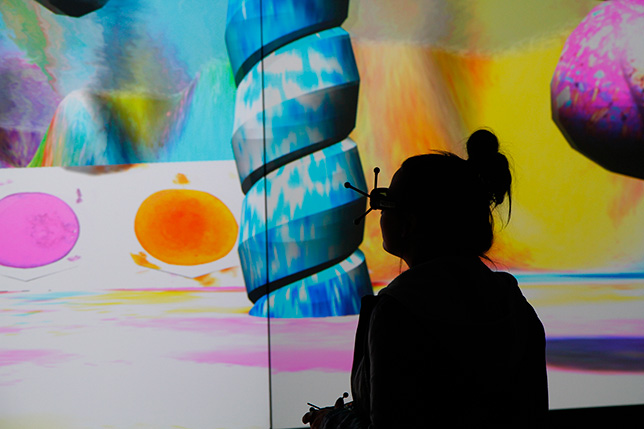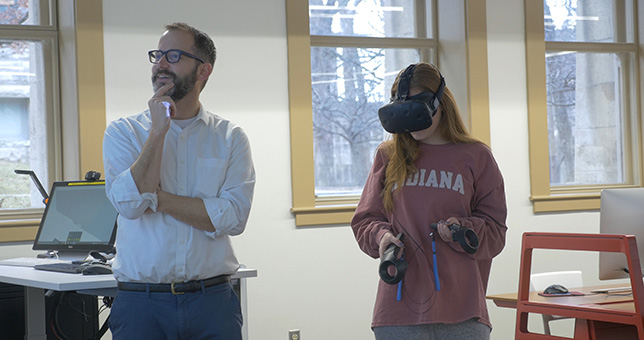When (Virtual) Reality Meets the Classroom
Spurred by a new era of affordable, mainstream virtual reality tools, Indiana University is incorporating VR into high-tech classrooms called Reality Labs.
- By Julie Johnston, Michael Boyles
- 03/07/17

IU undergraduate student Hailey Speciale uses large-screen projection displays and a tracking system to exhibit VR work created with Margaret Dolinsky, associate professor in the School of Art and Design.
Indiana University (IU) has enjoyed a long and successful history of using virtual reality for research and creative endeavors. Over the past two decades, hundreds of university faculty and students have immersed themselves in 3D environments and virtual simulations. Unfortunately, this work was limited to a handful of spaces, required costly hardware and depended on a small set of shared software resources. Large-format projection systems (taking up hundreds of square feet and costing hundreds of thousands of dollars) and custom applications were common.
Over the past couple of years, virtual reality (VR) has experienced a renaissance. Quality VR display technology is affordable and backed by big tech corporations. Software distribution platforms, such as Steam, allow VR applications to be easily downloaded and installed. These platforms are experiencing growth similar to that of the app stores for mobile devices and have a rapidly expanding selection of downloadable applications and experiences. Plus, modern VR displays no longer require lots of real-world space. The standard configuration consists of a single head-mounted display, connected to a computer via a single cable, as well as two wireless hand controllers.
Excited by these developments, as well as by increased interest among university departments, IU's University Information Technology Services (UITS) team was eager to expand its support for VR. In Q4 2016, leadership decided to incorporate VR technologies into general-inventory classrooms called Reality Labs.
About Reality Labs
Reality Labs are created from existing classroom or lab spaces and contain an instructor station plus around 10 to 30 student stations. Each of these stations includes an Acer G1 Predator gaming computer and an HTC Vive head-mounted VR display. A shared, room-wide VR tracking space facilitates immersion in the virtual simulations. At the same time, a large-format display (such as a projector or tiled video wall) allows non-immersed users to share in the virtual experience and also supports collaborative critiques and reviews. It is important to note that Reality Labs can still provide complete educational functionality for classes that do not require VR. The VR equipment is essentially an optional peripheral; it can be used when required or simply ignored.
We have identified three primary use cases for Reality Labs. First, expanding libraries of commercially developed applications provide new opportunities for non-technical disciplines to use VR to enhance existing curriculum. One example would be the use of a commercial (purchased off the shelf) immersive anatomy simulation to supplement existing anatomy courses. Before the advent of these rich application libraries, an instructor would have to work with local developers for several months to create such a simulation.
The second use case is the integration of student-created media and/or 3D models into existing applications and frameworks. This case is exciting, as it provides an introduction to the development of virtual experiences without requiring a sophisticated technical background. An example is the use of 360-degree spherical images or videos to visualize or recreate geographically remote locations.
The third use case is the creation of unique virtual experiences. This case is a bit more complex and requires some level of programming, but it also allows complete customization and is ideal for computing disciplines.
Faculty Perspectives
In classrooms, multiple students experience the VR at the same time, which creates an environment for shared experiences and consistent peer review. VR allows designers to quickly prototype full-scale designs, be it architecture or a product, and immediately see any shortcomings in their design iteration. "I've been using VR in my classroom and I've seen students demonstrate a richer understanding of their designs through the use of VR," said Jon Racek, senior lecturer in the School of Art and Design. "Students can experience if the scale, proportion, and other spatial qualities of their designs are appropriate."
This past semester in Racek's class, Fortune 500 company Kimball asked students to help imagine new co-working spaces. The students used VR to present their final proposals to Kimball in a much richer way than computer renderings would have allowed. The furniture designs were then prototyped using 3D printers and laser cutters. Students used VR to test out new ideas more quickly and easily than making a 3D print. They could switch back to their 3D modeling software and make changes, and then jump back into VR to see their fixes in full scale. VR allows for a richer and more complete understanding of their designs than a 2D drawing or computer rendering on their monitors.

Instructor Jon Racek provides feedback and comments on a student's design while she walks through her project.
In the School of Art and Design, associate professor Margaret Dolinsky stated, "My goal is to have students bring their imagination and research interests to the virtual worlds that they create. I would like them to define virtual reality as its own medium, separate from the tropes used in video games or cinema, and to concentrate on how they offer an experience to their visitors." As VR becomes more accessible and affordable, Dolinsky encourages students — especially women and minority students —to combine aesthetics and creative technologies. "For my classes, I focus on the experiential phenomena of art making and perception shifting using a variety of virtual strategies – digital drawing, digital painting and digital sculpting as well as scanning and photographic techniques to create virtual worlds."
Incorporating Virtual Reality Into Classrooms
The project leveraged existing in-house expertise to create these opportunities for students in a variety of classroom settings across campus. The UITS Learning Technologies division provided expertise related to active learning and classroom design. The Research Technologies division provided expertise related to VR technology, as well as workflows for the effective use and creation of immersive applications. Additionally, faculty using VR in the School of Art and Design, School of Media and School of Informatics & Computing were instrumental to both the planning and implementation phases. Their enthusiasm helped secure the backing of university leadership, and their willingness to experiment and adjust their curriculum will directly correlate to the project's success and student adoption. Collectively, these groups collaborated to form a team with the comprehensive vision and necessary skills to create an innovative and scalable solution for the entire university system.
Next Steps: Expanding Reality
To capitalize on the rapidly growing interest in VR and expand it to as many faculty and students as possible, IU has an aggressive plan to deploy at least six more Reality Labs across its Bloomington and Indianapolis campuses by fall 2017. In addition, the team is developing a support model that includes a technology integration specialist to assist faculty interested in exploring this technology.
The UITS Learning Technologies division has spent the last few years creating a variety of active learning classrooms, purpose-built with a variety of designs and technologies. The introduction of VR continues to create new challenges for the learning space design team. The current project is to redesign a large Reality Lab that will not only foster peer review during the design process, but also allow for final viewing of student products within the space. This space will be the first redesigned specifically to foster the technology activities in the classroom. Findings will drive the expansion of these technologies to further innovative experiences for students.
And virtual reality is only the beginning. The Reality Labs will evolve over the next several years to incorporate emerging and maturing areas of technology, including augmented reality (AR) and methods for capturing reality. AR blends our view of the real world with synthetic media and graphics, and requires a smaller physical footprint with fewer input devices than VR. Methods for capturing reality include 3D scanning and 360-degree and 3D cameras; these methods further lower the barrier of entry for faculty and students wanting to create their own content for VR or AR.